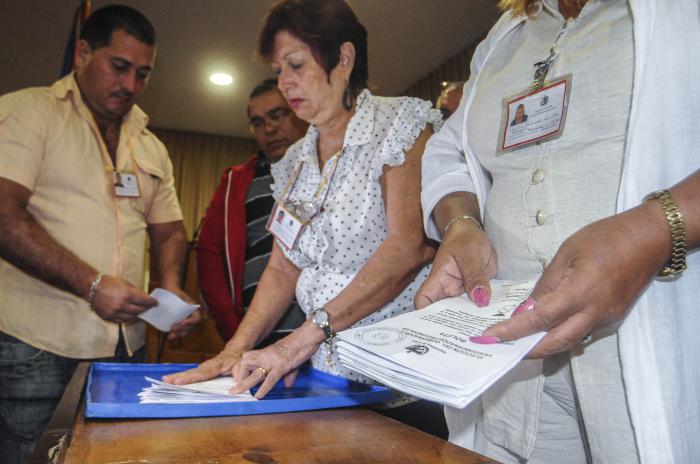Cuba Now Has Provincial Governors; What Does that Mean?
Running to stay on the same spot
Por Ale Dumarais

HAVANA TIMES – Well, after the “elections” this past weekend, Cuba has provincial governors who will officially take on their positions on February 8th.
Abiding by the constitutional amendments approved in a referendum vote last year, the position of president of the Provincial Assembly of People’s Power and even the Assembly itself, had previously disappeared and have now given way to authorities which seem to move away from structures that had been copied off the Soviet system, at least in name.
That said, what role have voters played? The ordinary citizen who watches on with suspicion or indifference as these changes take place? Well, nothing really. Polling stations only opened for representatives of municipal assemblies who left their ballot paper there which… Well, this ballot paper, featuring the positions of governor and vice-governor, wasn’t made public in advance.
There wasn’t an election campaign, or even those photos which appear on the walls of street corners, bodega stores during other elections, where you can read a short biography about each candidate which mentions their academic qualifications and participation in organizations such as the Communist Party, the Committees for the Defense of the Revolution, etc. (according to party-line newspaper Granma, this information had been previously sent to representatives who voted).
Locals in provinces had no idea who the candidates were who might potentially rule over them (and they might not have cared at all, that also might be true) and, even though it’s supposed that public opinion and suggestions are compiled, a list of potential governors never made it to the public.
It wasn’t required either, at least by the Constitution, as it is the President of the Republic who proposes candidates who he/she thinks might be the right people for the positions in the strange democracy it outlines, and representatives of Municipal Assemblies of People’s Power are limited to voting (in reality, approving) this single candidature (the right, the real ability to choose and not just ratify other people’s decisions, continues to be a pipe-dream).
According to what we were told in the evening hours on Saturday by Alina Balseiro, president of the National Electoral Board, every single candidate, all of the proposed governors and vice-governors, received over 90% of valid ballots, which are numbers you’ll rarely find in Latin American and European democracies, but they continue to be the norm in our electoral processes. Government media will then go on to highlight the transparency of, the extremely high quorum, high presence of women candidates, the ethnic diversity of candidates, their education level.
What is the government’s plan with those who are taking on their new positions? In reality, nobody believes they have one other than the pamphlet, the never-ending appeal to overcome shortages, blame the US government for all of the Cuban people’s hardship and troubles and to call upon them to carry on working selflessly.
That said, what concrete power will these new figures have? How will they carry out their work? What is the new provincial system of government they propose? Will it have any real autonomy to make the changes that Cuban society needs?
This change, which joins others such as the appointment of Manuel Marrero as Prime Minister and the renewal of positions at the head of some ministries and vice-presidencies, doesn’t really affect the national political and social reality.
At the end of the day, the Constitution clearly establishes the leading role the Communist Party plays ad infinitum, so the real authority of these new public figures and the room they have to make their own decisions is limited to the schemes of the Party’s ironclad core which continues to be controlled by Raul Castro and the Revolution’s historic figures.
It has been said many times before. Changes in Cuba are like cosmetic touch-ups, part of this age-old policy of changing everything so that everything carries on the same, living like the red queen takes Alice’s hand again to crazily run towards nowhere.
Here is the list of the new governors and vice-governors, by province, and the votes they received in the closed election.
Pinar del Río
Gobernador: Rubén Ramos Moreno
Porciento de votación: 99.44%
Vicegobernador: Niurka Rodríguez Hernández
Porciento de votación: 96.61%
Artemisa
Gobernador: Ricardo Concepción Rodríguez
Porciento de votación: 99.10%
Vicegobernador: Yamina Duarte Duarte
Porciento de votación: 97.59%
La Habana
Gobernador: Reinaldo García Zapata
Porciento de votación: 98.24%
Vicegobernador: Yanet Hernández Pérez
Porciento de votación: 94.95%
Mayabeque
Gobernador: Tamara Valido Benítez
Porciento de votación: 94.73%
Vicegobernador: Manuel Aguiar Lamas
Porciento de votación: 93.67%
Matanzas
Gobernador: Mario Felipe Sabines Lorenzo
Porciento de votación: 98.00%
Vicegobernador: Marieta Caridad Poey Zamora
Porciento de votación: 96.94%
Villa Clara
Gobernador: Alberto López Díaz
Porciento de votación: 98.78%
Vicegobernador: Milaxy Yanet Sánchez Armas
Porciento de votación: 98.47%
Cienfuegos
Gobernador: Alexandre Corona Quintero
Porciento de votación: 99.03%
Vicegobernador: Yolexis Rodríguez Armada
Porciento de votación: 97.86%
Sancti Spiritus
Gobernador: Teresita Romero Rodríguez
Porciento de votación: 95.00%
Vicegobernador: Frank Osbel Cañizares Rodríguez
Porciento de votación: 97.81%
Ciego de Ávila
Gobernador: Tomás Alexis Martín Venegas
Porciento de votación: 99.63%
Vicegobernador: Ania Rosa Francisco Malde
Porciento de votación: 97.25%
Camagüey
Gobernador: Yoseily Góngora López
Porciento de votación: 98.24%
Vicegobernador: Carmen María Hernández Requejo
Porciento de votación: 97.65%
Las Tunas
Gobernador: Jaime Ernesto Chiang Vega
Porciento de votación: 99.85%
Vicegobernador: Yelenys Tornet Menéndez
Porciento de votación: 97.71%
Holguín
Gobernador: Julio César Estupiñán Rodríguez
Porciento de votación: 97.74%
Vicegobernador: Yunia Pérez Hernández
Porciento de votación: 95.81%
Granma
Gobernador: Francisco Alexis Escribano Cruz
Porciento de votación: 95.69%
Vicegobernador: Yanetsy Terry Gutiérrez
Porciento de votación: 99.68%
Santiago de Cuba
Gobernador: Beatriz Johnson Urrutia
Porciento de votación: 99.58%
Vicegobernador: Manuel Falcón Hernández
Porciento de votación: 95.76%
Guantánamo
Gobernador: Emilio Matos Mosqueda
Porciento de votación: 99.83%
Vicegobernador: Alis Azahares Torreblanca
Porciento de votación: 98.81%






It has been said that ” the day we all become of the same thinking the world will end. “